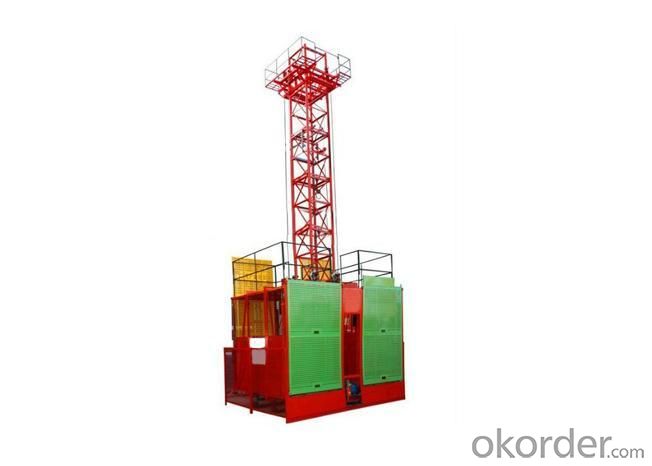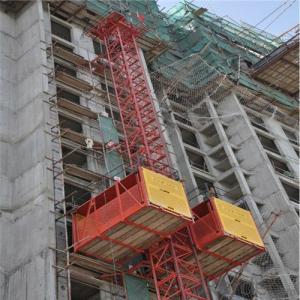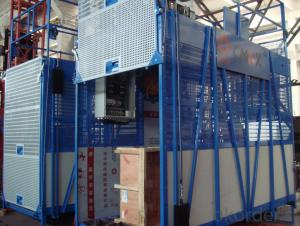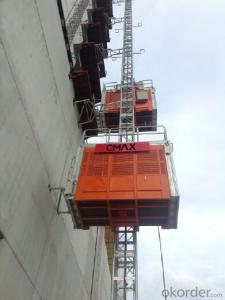SC 100/100 Building Hoist in China
- Loading Port:
- China Main Port
- Payment Terms:
- TT or LC
- Min Order Qty:
- 1 Set set
- Supply Capability:
- 100 Sets per Year set/month
OKorder Service Pledge
OKorder Financial Service
You Might Also Like
Detailed Product Description of China SC 100/100 Building Hoist
1Rated load:1000/1000kg
2lift passenger:12/12
3lift speed:0~36m/min
4without counter weight
Specification of of China SC 100/100 Building Hoist
Model | SC100 | SC100/100 | SC200/200 |
Height (m) | 12 | 12 | 50 |
Rated Loading Capacity (kg) | 1000 | 1000/1000 | 2000/2000 |
Rated Lifting Speed (m/min) | 36 | 36 | 36 |
Rated Passenger Number | 12 | 12/12 | 24/24 |
Motor Power (kw) | 2*11 | 2*2*11 | 2*3*11 |
Inner Dimension of Cage (m) | 3*1.3*2.5 | 3*1.5*2.5 | 3*1.5*2.5 |
Cage Weight (kg) | 1400 | 1400 | 1400 |
Mast Section Weight (kg) | 163 | 163 | 163 |
Mast Section Dimension (mm) | 650*650*1508 | 650*650*1508 | 650*650*1508 |
Rated Hanger Lifting Capacity (kg) | 180 | 180 | 180 |
Bottom Outline Dimension (mm) | 3100*4200 | 3100*4200 | 3100*4200 |
Numbers of Containers Needed for Shipment | One 20GP | One 40HQ | One 40HQ+One 20GP |
- Q: This question asks for a comparison of the pros and cons associated with the use of electric building hoists in construction.
- <p>Electric building hoists offer several advantages such as ease of operation, reduced manual labor, and increased efficiency in lifting and transporting materials. They are also safer compared to manual hoists, reducing the risk of accidents. Additionally, they can handle heavier loads and operate in various weather conditions. However, they have some disadvantages too. For instance, they require a power source and can be less reliable during power outages. They also involve higher initial costs and maintenance expenses. Electric hoists can be noisy, which may lead to noise pollution, and they can be complex to install and operate, requiring skilled personnel.</p>
- Q: Safe use of construction elevator
- 1. Construction enterprises must establish and improve the construction lifter of all kinds of management system, the implementation of the professional institutions and management personnel, clear the safe use and management responsibility system at various levels. The driver of the elevator should be trained by the competent department of the relevant administrative department for the training of qualified personnel. The driver should do the routine inspection, namely, when the elevator is first run, each class should be free and full of trial operation. 4. Establish and implement the system of regular inspection and maintenance, each week or each ten-day of elevator to conduct a comprehensive inspection, to find out the hidden dangers in accordance with the "armed" principle to carry out the rectification. After the rectification must be checked and confirmed by the relevant personnel, the safety requirement will be used.
- Q: This question asks for measures to protect lifting equipment from damage during its operation.
- <p>To prevent damage to lifting equipment during operation, ensure regular maintenance and inspection are conducted to check for wear and tear. Adhere to the equipment's load limits and never exceed them. Use appropriate lifting techniques and ensure the load is balanced. Keep the equipment clean and free from debris. Train operators thoroughly on safe operating procedures. Avoid sudden starts or stops, and ensure all safety features and guards are in place and functioning correctly. Regularly check cables, hooks, and other critical components for any signs of damage. Always follow the manufacturer's guidelines and industry safety standards.</p>
- Q: Is it possible for a building hoist to simultaneously lift and lower various materials?
- <p>Yes, a building hoist can be used to raise and lower different materials at the same time, provided it has the necessary capacity and the materials are properly secured. This is often done by using multiple hooks or platforms, each designated for different materials. It's crucial to ensure that the combined weight does not exceed the hoist's load limit and that safety protocols are strictly followed to prevent accidents.</p>
- Q: The user is asking if it's possible to use a building hoist, typically used for construction, to lift a car.
- <p>Using a building hoist to lift a car is not recommended. Building hoists are designed for lifting materials and equipment in construction settings, not for vehicles. They may not have the appropriate safety features or load-bearing capacity for a car. Attempting to lift a car with a building hoist could result in damage to the car, the hoist, or even personal injury. For lifting a car, it's best to use a vehicle-specific lift or a hydraulic lift designed for such purposes, ensuring safety and proper support.</p>
- Q: This question asks for measures to avoid accidents that may occur due to the misuse of a building hoist.
- <p>To prevent accidents caused by improper use of a building hoist, it's crucial to follow safety protocols strictly. Ensure all hoist operators are trained and certified. Regularly inspect and maintain the hoist equipment to check for any defects or wear. Never overload the hoist, and always secure the load properly. Implement clear communication procedures among workers, especially when the hoist is in operation. Set up barriers or warning signs to keep unauthorized personnel away from the hoist area. Finally, conduct regular safety drills to prepare for emergencies and reinforce safety practices among the workforce.</p>
- Q: This question asks about frequent issues related to building hoists and seeks solutions for these problems.
- <p>Common problems with building hoists include mechanical failures, electrical issues, overloading, and safety malfunctions. Mechanical failures can be fixed by regular maintenance, lubrication, and replacement of worn parts. Electrical problems may require checking wiring, connections, and replacing faulty components. Overloading can be prevented by strictly adhering to the hoist's weight limit and using load indicators. Safety malfunctions, such as brake failure, require immediate attention and may involve replacing brake pads or overhauling the braking system. Always ensure that hoists are used according to the manufacturer's guidelines and are regularly inspected by qualified personnel to prevent accidents and ensure safe operation.</p>
- Q: This question asks for a comparison of the pros and cons associated with the use of building hoists in construction projects.
- <p>Building hoists offer several advantages, including increased efficiency in material transportation, reduced labor costs, and improved safety by minimizing the need for manual handling at height. They can also be used for personnel transport, enhancing site accessibility. However, there are disadvantages such as high initial costs, the need for regular maintenance and inspection, and potential downtime due to mechanical issues. Additionally, they require space for installation and can obstruct views or access during operation. Safety concerns also arise if not properly managed, as accidents can occur due to operator error or mechanical failure.</p>
- Q: This question asks for guidelines on how to take care of lifting equipment after it has been used.
- <p>To maintain your lifting equipment after use, follow these steps: 1. Clean the equipment thoroughly to remove dirt, grease, and any debris. 2. Inspect all components for wear, damage, or signs of excessive use. 3. Lubricate moving parts as per the manufacturer's recommendations. 4. Check and tighten all bolts, nuts, and fasteners to ensure they are secure. 5. Store the equipment in a dry, clean, and well-ventilated area to prevent rust and corrosion. 6. Regularly review the manufacturer's maintenance schedule and perform any required servicing. 7. Keep a log of all maintenance and inspections to ensure you're staying on top of equipment care. Proper maintenance not only prolongs the life of your equipment but also ensures safety during use.</p>
- Q: This question is asking for a comparison between electric and hydraulic building hoists, focusing on their differences.
- <p>Electric and hydraulic building hoists differ primarily in their power source and operational mechanisms. Electric hoists use electric motors to lift and lower loads, which makes them more energy-efficient and quieter in operation. They also tend to have fewer maintenance requirements and are often easier to control with precise movements. Hydraulic hoists, on the other hand, use hydraulic pressure to move loads and are known for their ability to lift heavy loads with less effort. They are often preferred for applications requiring high lifting capacities and can be more compact. However, hydraulic hoists may require more maintenance due to the presence of seals and fluid systems, and they can be noisier than electric hoists.</p>
1. Manufacturer Overview
| Location | Beijing,China |
| Year Established | 2003 |
| Annual Output Value | |
| Main Markets | 15.00% Eastern Europe 15.00% South America 10.00% Mid East 10.00% Western Europe 10.00% North America 5.00% Oceania 5.00% Eastern Asia 5.00% Central America 5.00% Southeast Asia 5.00% Northern Europe 5.00% Southern Europe 5.00% South Asia 5.00% Africa |
| Company Certifications | ISO9001:2000;CE |
2. Manufacturer Certificates
| a) Certification Name | |
| Range | |
| Reference | |
| Validity Period |
3. Manufacturer Capability
| a) Trade Capacity | |
| Nearest Port | 11-20 People |
| Export Percentage | 21% - 30% |
| No.of Employees in Trade Department | |
| Language Spoken: | |
| b) Factory Information | |
| Factory Size: | 10,000-30,000 square meters |
| No. of Production Lines | 5 |
| Contract Manufacturing | |
| Product Price Range | |
Send your message to us
SC 100/100 Building Hoist in China
- Loading Port:
- China Main Port
- Payment Terms:
- TT or LC
- Min Order Qty:
- 1 Set set
- Supply Capability:
- 100 Sets per Year set/month
OKorder Service Pledge
OKorder Financial Service
Similar products
Hot products
Hot Searches
Related keywords
























